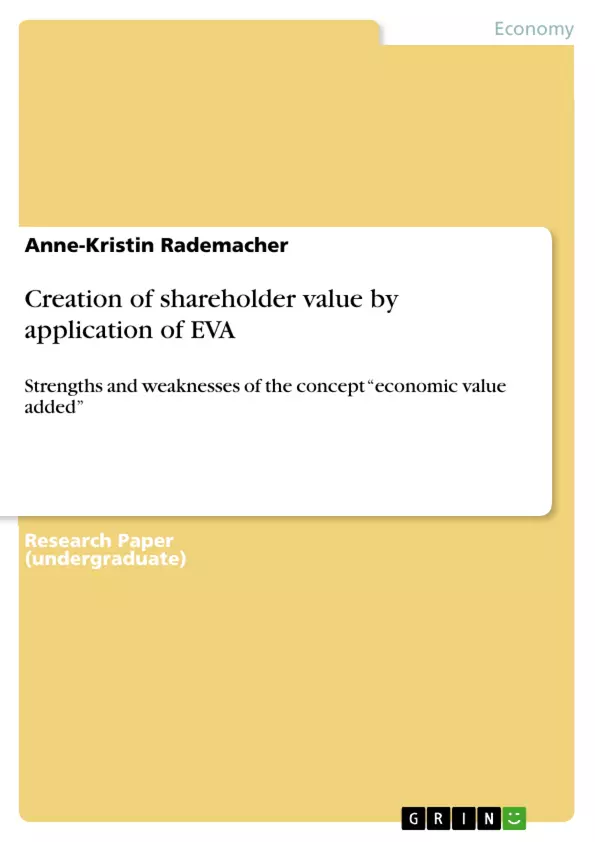Creation of shareholder value; this simple idea has become a principle of corporate governance over the past fifty years (Lazonick et al, 2000). Managers shall maximize the value of their business by efficiently allocating resources and hence increase the wealth of shareholders (Worthington et al, 2001). The operationalization of this objective is done by various indicators. Shareholders, managers and other interested parties strongly follow these in order to assess business and predict future performance. EVA is one of these indicators.
The following paper presents the concept and measurement behind the trademark EVA. It is practically applied for the company Fresenius in a simplified way. Theoretical and practical analyses reveal strengths and weaknesses of measurement and concept. In general it can be said that EVA is one approach to identify value creation and degrading. The concept can be used for investment decisions as well as performance appraisal. Main disadvantage has been identified to be a high degree of complexity in order to derive the true EVA. If adjustments are not made the measurement appears to be similar to other residual income indicators.
Inhaltsverzeichnis (Table of Contents)
- Executive Summary
- List of content
- List of figures and tables
- List of abbreviations
- 1 Introduction
- 2 Theoretical conception of EVA
- 3 Calculation of the measurement
- 3.1 Rate of return - r
- 3.2 Cost of capital - WACC and CAPM
- 3.3 Conversions in the measurement
- 4 Application of EVA - example Fresenius
- 4.1 Indicating the critical parameter for Fresenius
- 4.2 Calculation of the measurement EVA
- 4.3 EVA compared to other measurements
- 5 Evaluation of the concept
- 5.1 Strengths of EVA
- 5.2 Weaknesses of EVA
- 6 Summary
- List of literature
- Appendix
Zielsetzung und Themenschwerpunkte (Objectives and Key Themes)
This paper aims to explore the concept of Economic Value Added (EVA) as a tool for shareholder value creation. It examines the theoretical framework behind EVA, delves into its calculation and application, and analyzes its strengths and weaknesses. The paper uses a simplified case study of Fresenius to illustrate the application of EVA.- Conceptual Understanding of EVA
- Calculation and Measurement of EVA
- Application of EVA in Practice
- Strengths and Weaknesses of EVA
- EVA compared to other value indicators
Zusammenfassung der Kapitel (Chapter Summaries)
- Introduction: This chapter introduces the concept of shareholder value creation and highlights the significance of EVA as a value indicator.
- Theoretical conception of EVA: This chapter provides a theoretical foundation for EVA, outlining its definition, principles, and the rationale behind its use.
- Calculation of the measurement: This chapter details the steps involved in calculating EVA. It covers the calculation of the rate of return, cost of capital, and adjustments required for accurate measurement.
- Application of EVA - example Fresenius: This chapter demonstrates the application of EVA to a specific company, Fresenius. It outlines the critical parameters for the company and provides a step-by-step calculation of EVA. Additionally, it compares EVA to other value indicators for Fresenius.
- Evaluation of the concept: This chapter critically examines the strengths and weaknesses of EVA as a value creation tool, highlighting its advantages and limitations.
Schlüsselwörter (Keywords)
The key concepts discussed in this paper are centered around the concept of shareholder value creation and the application of EVA as a tool for measuring and maximizing value. Key themes include: EVA, shareholder value creation, cost of capital, rate of return, performance measurement, investment decisions, Fresenius, strengths and weaknesses of EVA, and value indicators.- Citar trabajo
- Anne-Kristin Rademacher (Autor), 2012, Creation of shareholder value by application of EVA , Múnich, GRIN Verlag, https://www.grin.com/document/213654



